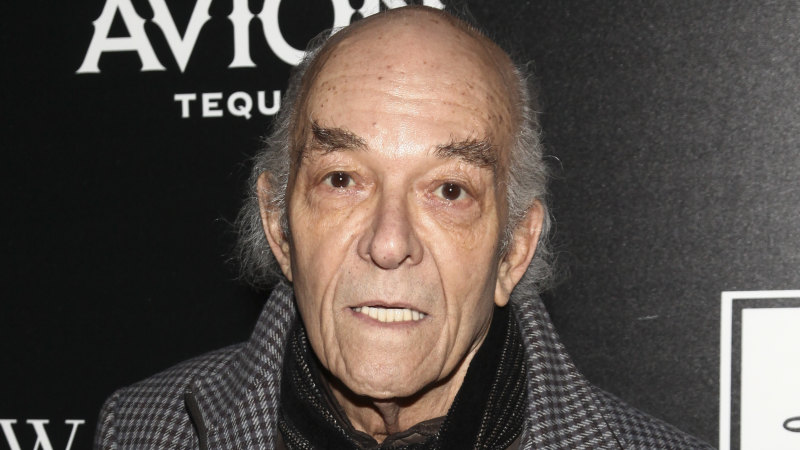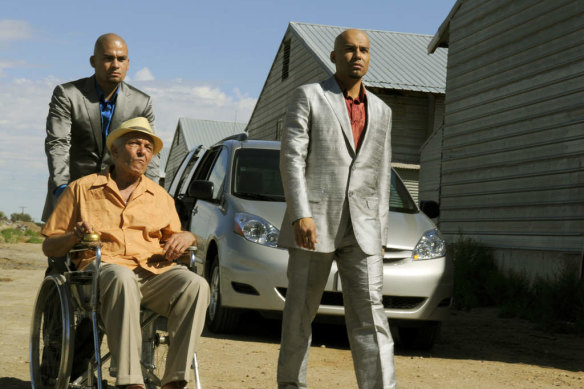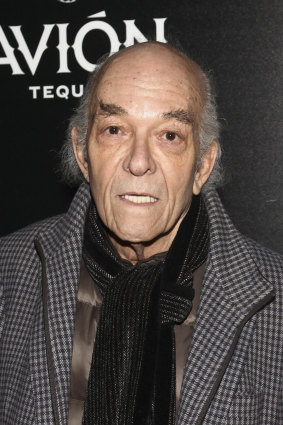Save articles for later
Add articles to your saved list and come back to them any time.
Mark Margolis, the prolific actor whose simmering air of menace as the fearsome former drug lord Hector Salamanca in Breaking Bad transformed the innocent ding of a bellhop bell into a harbinger of doom, died Thursday in New York. He was 83.
His death, at Mount Sinai Hospital following a brief illness, was confirmed in a statement on Friday by his son, Morgan Margolis. Mark Margolis had lived in the same apartment in Manhattan’s TriBeCa neighborhood since 1975.
Tio Salamanca, (Mark Margolis), in a wheelchair, with Marco Salamanca (Daniel Moncada), left, and Marco Salamanca (Luis Moncada) in the third season of Breaking Bad.Credit: AP
In a long career, he had more than 160 credits in movies and on television, gaining notice early on with memorable roles in Brian De Palma’s Scarface (1983) and the Jim Carrey comedy Ace Ventura: Pet Detective (1994).
He also became a go-to actor for director Darren Aronofsky, appearing in his films π (or Pi) in 1998, Requiem for a Dream (2000), The Fountain (2006), The Wrestler (2008), Black Swan (2010) and Noah (2014).
But no role made him as instantly recognisable to millions of viewers as his Hector in Vince Gilligan’s critically acclaimed AMC series Breaking Bad, starring Bryan Cranston, Aaron Paul, Anna Gunn and Giancarlo Esposito, and its prequel, Better Call Saul, with Bob Odenkirk and Rhea Seehorn.
The role, in Breaking Bad, brought him an Emmy nomination in 2012 for outstanding guest actor in a dramatic series.
His Hector, or Tio, was indelible. An aging former drug cartel don, Hector had come to live in a New Mexico nursing home, unable to speak or walk following a stroke but still firmly in control of his power as a rival to Walter White (Cranston), a mild-mannered high school chemistry teacher who evolves into a kingpin in the crystal meth trade.
Despite his lack of dialogue in Breaking Bad, Margolis proved a scene-stealer from his wheelchair, his eyes bulging, his face trembling with rage, despite the nasal cannula pumping oxygen up his nose and his palm furiously banging his bell, taped to an arm of the chair, whenever he needed attention.
“I tell people I’m the second-most famous bell ringer after Quasimodo,” he said in a 2016 interview with Vulture, New York magazine’s culture site.
As a young actor, he added, he had trained to communicate emotions without dialogue. He also borrowed mannerisms, including a tobacco-chewing motion with the side of his mouth, from his mother-in-law, who had been confined to a Florida nursing home after a stroke.
As viewers discovered in Better Call Saul, which featured Margolis as an ambulatory and verbose Hector, the character had wound up in a wheelchair after a defector in his organisation switched his medication to incapacitate him, leading to the stroke.
Despite the character’s broken moral compass and hair-trigger rage, Margolis managed to evoke Hector’s complexity – his humanity, even.
“You don’t play villains like they are villains,” he said in a 2012 interview with The Forward, the Jewish newspaper. “You play them like you know exactly where they are coming from. Which hopefully you do.”
Margolis in February 2018.Credit: AP
Mark Margolis was born on November 26, 1939, in Philadelphia to Isidore and Fanya (Fried) Margolis. He attended Temple University briefly before moving to New York, where at 19 he got a job as a personal assistant to method acting guru Stella Adler. He also took a class with Lee Strasberg at his famed Actors Studio.
After making brief appearances on television shows such as Kojak and in movies such as the Dudley Moore comedy Arthur and De Palma’s Dressed to Kill (both from 1981), Margolis got his first taste of renown in Scarface, playing Alberto the Shadow, a bodyguard and hit man for Alejandro Sosa (Paul Shenar), the Bolivian drug boss who shows Pacino’s Tony the ropes in the cocaine business.
In one slyly comic moment in Breaking Bad, Hector is seen watching on television a famous scene from Scarface in which Tony spontaneously shoots Alberto in the head when he learns that Alberto’s planned car-bomb murder of a nosy journalist would also kill the journalist’s wife and children.
Despite his turns as a Latin heavy, Margolis, who was Jewish, did not speak Spanish, a point that earned him no shortage of derision from native speakers.
“I’ve lived in Mexico,” he said in the 2016 interview with Vulture. “I know enough of the grammar of it, and I’m pretty good with the accent of it. If I get a good tutor, I can lock into it pretty quickly.”
In addition to his son, he is survived by his wife of 61 years, Jacqueline Margolis; a brother, Jerome; and three grandchildren.
This article originally appeared in The New York Times.
Most Viewed in Culture
From our partners
Source: Read Full Article




